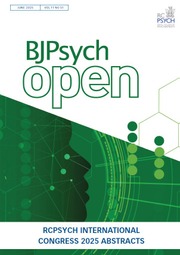Patterns of Insomnia and Its Treatment in North Central London: Using Primary Care Data to Establish Unmet Needs and Health Inequalities
Published online by Cambridge University Press: 07 July 2023
Abstract
There is robust research evidence that insomnia is highly prevalent in the general population, with a significant adverse impact on physical and mental health and quality of life. There is also strong evidence of the cost-effectiveness of cognitive-behavioural therapy for insomnia (CBT-I), the first-line treatment for insomnia recommended by the UK's National Institute for Health and Care Excellence. However, data from primary care records has not been used in the UK to establish real-world impact, including local prevalence, treatment rates and inequalities. This study's aim was to establish these in North London.
Pseudonymised data were extracted from primary care records across three North London boroughs for 765,035 patients (aged 15+ years). Insomnia prevalence was determined by identifying patients with a code for insomnia in previous five years, sleeping tablet prescription in previous three months, or code for insomnia treatment. Data were aggregated upon extraction and analysed using descriptive statistics.
Insomnia prevalence was 4.3%. Prevalence increased steadily with age, being highest in those aged 85–90 years (10.8%). There was significant variation by ethnic group and deprivation quintile, with highest prevalence in the most deprived quintile (5.2%) and those of Bangladeshi ethnicity (7.3%). Variation in insomnia prevalence, diagnosis and treatment occurred between GP practices. Prevalence was significantly higher in patients with comorbidities, including those with chronic obstructive pulmonary disease (17.5%), diabetes mellitus (11.8%), severe mental illness (16.6%), and depression (14.1%). 0.3% of people with an insomnia code had been referred for CBT-I.
Insomnia was found to be as common as other illnesses that receive high levels of focus and resourcing in the UK. Prevalence estimates were likely underestimates since patients were only counted as having insomnia if this could be identified from coded data or prescription information. Significant variation in prevalence and treatment rates by factors such as ethnicity and deprivation quintile may represent health inequalities. Additionally, insomnia was particularly common among patients with certain comorbid illnesses and of advancing age, meaning that those groups should be actively screened for insomnia. Concerningly, referral rates for CBT-I were extremely low. It is vital that clinicians receive training in diagnosing insomnia and local treatment pathways, and that culturally appropriate services are commissioned to address this unmet need and ensure equitable access. Although this study included data from only one locality, it is consistent with international research findings. Therefore, prevalence and unmet need is likely to be high in many other areas and should be investigated locally.
Information
- Type
- Research
- Information
- BJPsych Open , Volume 9 , Supplement S1: Abstracts from the RCPsych International Congress 2023, 10–13 July , July 2023 , pp. S73 - S74
- Creative Commons
- This is an Open Access article, distributed under the terms of the Creative Commons Attribution licence (http://creativecommons.org/licenses/by-nc/4.0), which permits unrestricted re-use, distribution, and reproduction in any medium, provided the original work is properly cited. This does not need to be placed under each abstract, just each page is fine.
- Copyright
- Copyright © The Author(s), 2023. Published by Cambridge University Press on behalf of the Royal College of Psychiatrists
Footnotes
Abstracts were reviewed by the RCPsych Academic Faculty rather than by the standard BJPsych Open peer review process and should not be quoted as peer-reviewed by BJPsych Open in any subsequent publication.
- 1
- Cited by



eLetters
No eLetters have been published for this article.